

Digital Literacy. Brittney's Story - Posting Something You Regret. Digital Citizenship - Using Technology Appropriately. Nine Themes of Digital Citizenship. Nine Themes of Digital Citizenship Digital citizenship can be defined as the norms of appropriate, responsible behavior with regard to technology use. 1.

Digital Access: full electronic participation in society. Technology users need to be aware that not everyone has the same opportunities when it comes to technology. Common Sense Media - Digital Bytes Facilitator's Guide. MPCC: About the MNPCC. Mission The Minnesota Partnership for Collaborative Curriculum is a grassroots initiative to promote the creation of open digital curriculum.
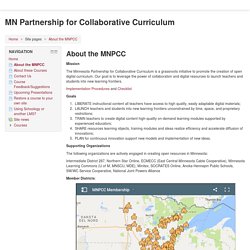
iKeepSafe/Google Digital Literacy Tour Videos. What is Digital Citizenship? Educational Technology and Mobile Learning: digital citizenship. New! Digital Citizenship Song and Video. Download the video for free! (Right-click, save) Something you may not know about us here at Common Sense Media, is that quite a few of us are former classroom teachers!
When we develop new materials, we always have our favorite memories to guide us. One thing we remember fondly is being amazed by how music transformed a classroom – kids would jump to their feet, whatever the song, to sing and sway while the teacher subtly wove word play and pattern recognition into the mix. This summer, we worked with a great animator and composer to create our first digital citizenship song for elementary students! The song plays off of our popular poster that illustrates how kids can use their heads, hearts, guts, arms, and legs to be a good digital citizen. To accompany the song, we've created this classroom-ready PDF bundle with posters illustrating each step toward being a good digital citizen!
Pause and Think Online From your head down to your toes, pause, think about it. Teaching Digital Citizenship. How to Take Digital Citizenship Schoolwide During the 2016-17 School Year. Since our students are using technology to play, learn, and communicate while at home and at school, they should be learning how to use that technology responsibly.

Full integration of digital citizenship (or DigCit) curriculum into every class and every content area—at every grade level—should be the goal to meet this need. Keep in mind that most teacher-prep programs do not incorporate digital citizenship alongside the other elements of teacher education. Here is how we trained all the teachers in our school—St. John’s Prep in Massachusetts—as well as the lessons we learned along the way and our recommendations for what might work in your school, too. Step 1: Clear Institution-Wide Communication. How To Spot Fake News. Critical thinking is a key skill in media and information literacy, and the mission of libraries is to educate and advocate its importance.
Discussions about fake news has led to a new focus on media literacy more broadly, and the role of libraries and other education institutions in providing this. When Oxford Dictionaries announced post-truth was Word of the Year 2016, we as librarians realise action is needed to educate and advocate for critical thinking – a crucial skill when navigating the information society. IFLA has made this infographic with eight simple steps (based on FactCheck.org’s 2016 article How to Spot Fake News) to discover the verifiability of a given news-piece in front of you.
Download, print, translate, and share – at home, at your library, in your local community, and on social media networks. The more we crowdsource our wisdom, the wiser the world becomes. Download the infographic Translations. The Google app - Download the app for Android and iPhone.
Google & Digital Citizenship - bpsedtechchromebooks. Be Safe & Search Savvy Regardless of the subject and grade level they teach, today's educators have a responsibility to teach their students how to effectively and safely navigate the web.
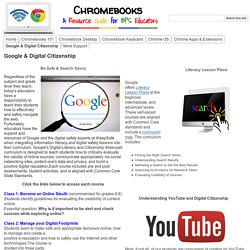
Fortunately, educators have the support and resources of Google and the digital safety experts at iKeepSafe when integrating information literacy and digital safety lessons into their curriculum. Google's Digital Literacy and Citizenship three-part curriculum is designed to teach students how to critically evaluate the validity of online sources, communicate appropriately via social networking sites, protect one's data and privacy, and build a positive digital reputation.Each course includes pre and post assessments, student activities, and is aligned with Common Core State Standards. Click the links below to access each course Students identify guidelines for evaluating the credibility of content online.
Five Good Resources for Teaching Digital Citizenship to Middle School and High School Students. In response to yesterday's post about digital citizenship lesson materials for elementary school students I received requests for middle school and high school resources.

Here are five of my favorite resources for teaching digital safety and digital citizenship to middle and high school students. Cyber Streetwise is a site developed for the purpose of sharing tips and techniques for protecting your identity and your electronic devices. The site is set-up as digital street that you walk along to learn about protecting your electronic devices, your identity, and digital footprint. Much of the content is geared toward businesses, but there is some good content for students and teachers too. Some of the content that applies to students and teachers includes crafting strong passwords, protecting mobile devices from malware, and responsible use of social media.
A Thin Line is a digital safety education resource produced by MTV in collaboration with other media partners. Resources - iKeepSafe. Fantastic Resources for Teaching Digital Citizenship Education in Your Classroom. About ETR Community EdTechReview (ETR) is a community of and for everyone involved in education technology to connect and collaborate both online and offline to discover, learn, utilize and share about the best ways technology can improve learning, teaching, and leading in the 21st century.
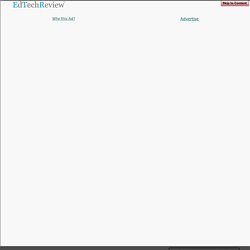
EdTechReview spreads awareness on education technology and its role in 21st century education through best research and practices of using technology in education, and by facilitating events, training, professional development, and consultation in its adoption and implementation. Digizen website. Digital Citizenship Week: 6 Resources for Educators. Considering how ubiquitous smartphones and tablets have become, especially in high school and middle school, questions about managing use and educating students about digital etiquette are on a lot of educators' minds.
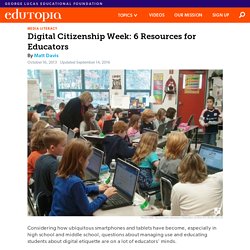
This October, Common Sense Media is sponsoring Digital Citizenship Week from October 16 to October 22. And we wanted to pull together some of the best resources to help educators talk about digital responsibility and safety online. Here, you'll find resources that cover today's digital landscape, ideas for student activities, and strategies for engaging parents. Digital Citizenship Starter Kit. Digital Citizenship in the Real World. Digital Citizenship | Feature Digital Citizenship in the Real World The Digital Driver's License is helping students navigate the hazards of the Internet.

Every new driver takes a test before ever taking the wheel. With so much at stake, it would be reckless not to. So it's something of a mystery why, in the age of increased attention on cyberbullying and online predators, schools aren't doing more to prep students for the inevitable realities of the Internet. Common Sense Education. Common Sense Education. An Updated Digital Differentiation Model. This is part of a Digital Differentiation model, my way i of weaving a web of flexible tools together for teaching and learning.

To keep the model relevant, frequent updates are required, as new tools and trends emerge. To access the most current resources, please click on the tab at the top of this blog: Digital Differentiation - Current Updating Ten months ago I published a Digital Differentiation model on this blog. Technology is a tool that can be used to help teachers facilitate learning experiences that address the diverse learning needs of all students and help them develop 21st Century Skills, an idea supported by the Common Core.
Be a Digital Citizen. 15 Top Resources On Digital Citizenship for 2014. A lot of the facts you teach your students will be long forgotten by the time they reach graduation, but the hope is that the practical lessons — the ones that can benefit them for years to come — are the ones that will stick.
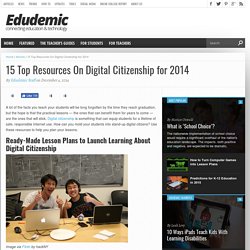
Digital citizenship is something that can equip students for a lifetime of safe, responsible Internet use. How can you mold your students into stand-up digital citizens? Use these resources to help you plan your lessons. Ready-Made Lesson Plans to Launch Learning About Digital Citizenship Image via Flickr by hackNY Ready-made lesson plans about digital citizenship can serve as the perfect launchpad for discussing this topic in class. 8 digital skills we must teach our children. The social and economic impact of technology is widespread and accelerating.
The speed and volume of information have increased exponentially. Experts are predicting that 90% of the entire population will be connected to the internet within 10 years. With the internet of things, the digital and physical worlds will soon be merged. These changes herald exciting possibilities. But they also create uncertainty.